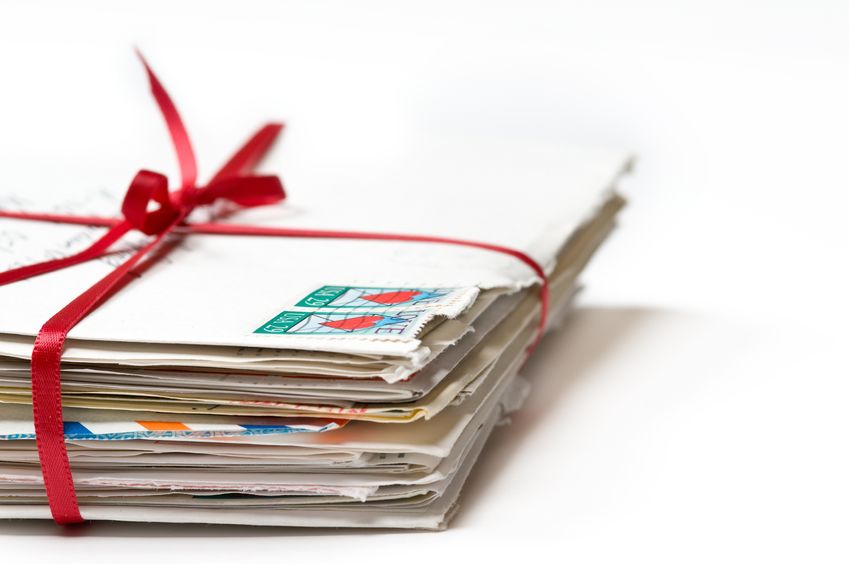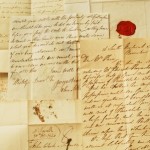We family history researchers often inherit lots of letters.
With email, it isn’t likely that this generation of family history researchers will have such boxes of handwritten papers to pass down to the next group of genealogy researchers. But for those of us who are still finding letters in attics, shoeboxes and drawers, what should we family history researchers do with these ramblings?
My mother, in her effort to de-clutter and downsize, began to hand them back to the people to whom her parents had sent the letters. I, the genealogy researcher in the family, was abolutely furious.
“Mom,” I told her. “I am the family history researcher. I’m the one who needs those letters.”
And I ordered her to never, ever, give away family letters without letting me see them first.
Letters and correspondence are big time sources for the family history researcher. They provide color, details, voice and more. Andrew Carroll, editor of the New York Times best sellers War Letters and Behind the Lines recently donated an entire collection of 100,000 war letters to Chapman University in Orange, California. He is still taking originals, photocopies and scans of letters from any conflict, including emails from Iraq and Afghanistan. Memorial Day is a good time to think about the war letters that you, the family history researcher, may have discovered in your ancestor search.
That’s how important correspondence is.
Think of all the books that have been published with written conversations between famous people, writers, presidents and other notables. Letters make for good reading. They give historic details and perspective to a time and place. They let us glimpse the personality of the writer.
What do we do when we find letters, though? And what do we do with a whole lot of them?
Preserve them. Photocopy, digitize, scan and store them carefully.
The family history researcher and genealogical archivist knows a few key things that will preserve the paper and ink, which are often fading, fragile and at risk for further age-related damage.
When a genealogy researcher preserves the paper, he or she will:
- Wash hands before touching any historic letters and limits the amount of handling.
- Remove rubber bands, staples and paper clips.
- Unfold the letters.
- Make a photo copy.
- Put the letters between two pieces of acid free and lignin free archival paper or folders.
- Or put the letters in clear sleeves ideally made of uncoated polyester, cellulose triacetate, polyethylene or polypropylene. (Polyester sleeves should not be used with flaking material, unfixed pastels, charcoal, or soft pencil.)
- Look for storage materials marked PAT (passed a photographic activit
- Organize them from largest on bottom to smallest on top.
- Store them in an acid free archival box, ideally front loading.
- Keep them out of the daylight and away from damp areas and radiators.
- Limit their exposure to humidity and monitor temperature.
- Never use adhesives or glue on or around them.
- Check regularly for and eliminates paper pests, including silver fish, “book lice” and others.
The way family history researchers digitize letters is to:
- Photocopy each of the letters flat.
- Scan the letter one side at a time into a good quality scanner.
- Include scanning the envelope in the process.
- Use high resolution
- Write the dates carefully with No. 1 pencil, using square brackets [December 5, 1900], on the outside of the preserving material. (Square brackets are the preservationists’ cue that the information was added later.)
Genealogical researchers will highlight the letters and will:
- Have a copy (not the original which you have stored correctly) professionally framed with acid free mats.
- Display the carefully framed letter copy in a place that is not in regular direct light.
- Add to an archival quality scrapbook, making sure all paper and mounting is done with acid free, lignin free materials.
- Use no current-day adhesives and no tape.
- Not expose the letter paper to cleaning supplies, cardboard, fumes.
- Consider using UV-screening glass.
RecordClick genealogy researchers will work with you on finding, understanding and preserving family correspondence. We will find those who served in the military and ancestors who fought in wars. We’ll also help you integrate the letters into your family tree research.








